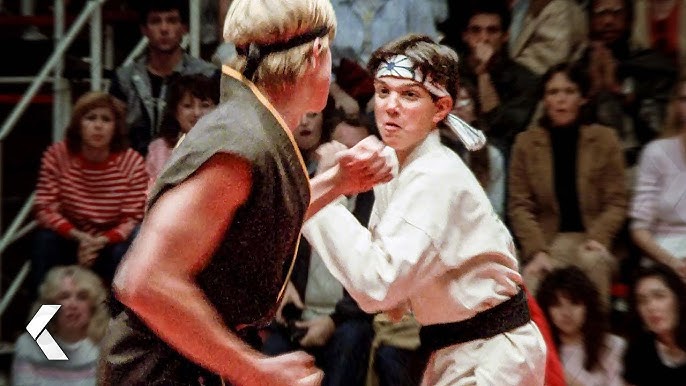The Karate Kid 1984

“The Karate Kid” (1984) Review
Director: John G. Avildsen
Written by: Robert Mark Kamen
Starring: Ralph Macchio, Pat Morita, Elisabeth Shue, Martin Kove, William Zabka
Plot Summary: “The Karate Kid” follows Daniel LaRusso (Ralph Macchio), a teenager who moves to a new town with his mother and struggles to fit in at his new high school. He becomes the target of bullying by a group of karate students led by Johnny Lawrence (William Zabka). Seeking to defend himself, Daniel finds an unlikely mentor in Mr. Miyagi (Pat Morita), a wise and skilled karate master. Under Mr. Miyagi’s guidance, Daniel learns karate, but more importantly, he gains confidence, discipline, and a deeper understanding of life.
Review:
1. Storyline and Themes: The film combines a classic coming-of-age story with the underdog sports narrative. At its heart, it’s about personal growth, self-discovery, and the transformative power of mentorship. The storyline is familiar but effective, using karate as a metaphor for overcoming personal obstacles and finding inner strength. The central themes of perseverance, honor, and the mentor-student relationship resonate throughout the film, making it both inspirational and relatable.
2. Performances: Ralph Macchio delivers a compelling performance as Daniel LaRusso, portraying his character’s journey from a vulnerable new kid to a confident young man with genuine sincerity. Pat Morita’s portrayal of Mr. Miyagi is a standout, infusing the character with wisdom, humor, and warmth. Morita’s performance earned him an Academy Award nomination for Best Supporting Actor and is widely regarded as one of his most iconic roles. William Zabka, as Johnny Lawrence, effectively embodies the role of the antagonist with a blend of arrogance and vulnerability, making him a memorable and nuanced villain.
3. Direction and Cinematography: John G. Avildsen’s direction captures both the intimate moments between Daniel and Mr. Miyagi and the larger, more dramatic scenes, such as the tournament climax. His approach to storytelling is straightforward yet effective, focusing on the emotional and motivational aspects of the narrative. The cinematography, by James Crabe, is functional and supportive, using the settings of suburban America and the karate tournament to create a vivid and engaging backdrop for the story.
4. Action and Martial Arts: The film’s martial arts sequences are both exciting and accessible. The training montages, including the iconic “wax on, wax off” scene, are memorable and serve as both a plot device and a symbol of Daniel’s growth. While the choreography may not be as intricate as in more recent martial arts films, it effectively conveys the discipline and skill required for karate, and the final tournament is a satisfying culmination of the training and personal development themes.
5. Music and Soundtrack: The soundtrack, featuring songs like “You’re the Best” by Joe Esposito and “Glory of Love” by Peter Cetera, adds to the film’s motivational and nostalgic appeal. The music complements the film’s emotional highs and lows, enhancing the overall viewing experience and contributing to its memorable status.
6. Reception and Legacy: “The Karate Kid” was a commercial and critical success upon its release, becoming a cultural touchstone for the 1980s. Its positive message and the strong performances by Macchio and Morita have cemented its place as a beloved classic. The film’s influence extends beyond cinema, inspiring a range of sequels, a remake, and even a successful TV series, “Cobra Kai,” which continues to explore the legacy of the original characters.
Conclusion: “The Karate Kid” is a classic film that combines elements of sports, drama, and personal growth with a memorable mentor-student dynamic. Its strong performances, particularly by Ralph Macchio and Pat Morita, and its inspirational themes have made it a lasting favorite. The film’s engaging story, iconic scenes, and motivational message ensure its place as a beloved and influential piece of 1980s cinema.











